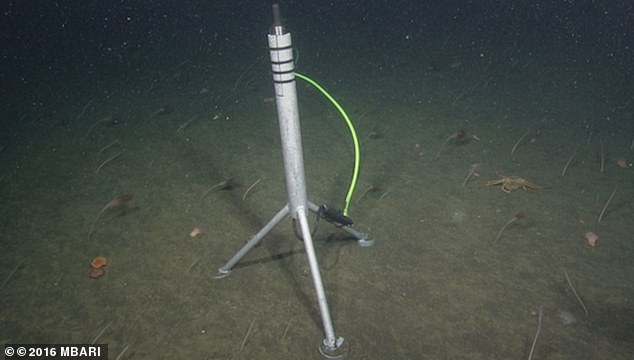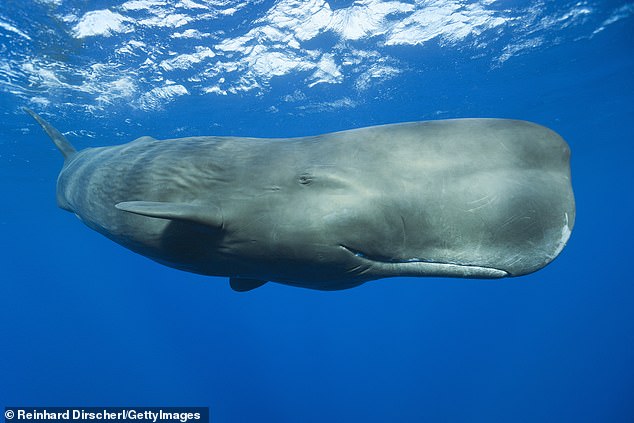Mysterious clicking sounds reveal rare apex predator lurking in California: ‘Sounded like a human machine’
A mysterious clicking sound detected thousands of feet beneath the surface of the Pacific Ocean has provided fascinating insights into California’s elusive sperm whale population.
The endangered giant sperm whale, the world’s noisiest animal, is rarely seen in Monterey Bay, Central California, and is difficult to study because of its long-lasting, deep diving abilities.
But a hydrophone (underwater microphone), embedded in the seabed and connected to the Monterey Bay Aquarium Research Institute in Moss Landing, made an incredible discovery after recording audio from 100 miles away for seven years.
During this time, they captured a series of strange staccato-like sounds that started slowly and then accelerated into a continuous crackle, resembling the hum of television static.
“It almost sounded like a human machine,” Will Oestreich, a postdoctoral researcher at the U.S. National Science Foundation, told MBARI. SFGATE.
But after wading through a mountain of data, Oestreich realized that these sounds were in fact the echolocation clicks of not one but several sperm whales hunting together in the area.
A mysterious clicking sound detected thousands of feet below the ocean’s surface off the coast of Central California has provided valuable insights into Monterey Bay’s elusive sperm whale population

A hydrophone (pictured), or underwater microphone, embedded in the seabed and linked to the Monterey Bay Aquarium Research Institute (MBARI) in Moss Landing, picked up a series of clicks that piqued the curiosity of Will Oestreich, a postdoctoral researcher at US National Science Foundation. colleague at MBARI
Sperm whales are known to produce the loudest biological sound on earth – up to 200 decibels – and use these powerful clicks to hunt in the pitch-black depths of the ocean.
‘Every click is a fraction of a second. It’s basically a needle in a haystack, even though it is the loudest known biological sound on Earth,” Oestreich said.
‘For us researchers it is a very cool tool, because they tell us things about their own lives. They are an apex predator – tigers of the deep sea – and their behavior reflects a food web that is difficult for us to study.”
The groundbreaking study published in Movement Ecology documented how these whales visit Monterey Bay much more regularly than previously thought, especially in late fall and winter.
This timing is in stark contrast to previous findings from Alaska, where summer sounds were more common, suggesting possible seasonal migrations that align with changing ocean conditions in the North Pacific, where prey are abundant.
Oestreich’s analysis went beyond simply detecting presence.
Using sophisticated algorithms, he tracked individual whales by analyzing the timing between clicks, which corresponds to body size, and revealed the presence of adult males, females with calves and younger whales, all indicative of Monterey Bay’s significance to the population .
Researchers also discovered codas, unique sound patterns that can act as “cultural identifiers” for different social groups.
Oestreich noted that these findings have conservation implications.
Sperm whale populations are still recovering from commercial whaling, and understanding their presence in protected areas such as the Monterey Bay National Marine Sanctuary could help protect against risks such as noise pollution and ship strikes.
“These are the predators with the largest teeth in the world,” Oestreich said. “They’ve been here all this time, but we just didn’t realize it.”

Sperm whales, known to produce the loudest biological sound on earth – up to 200 decibels – use these powerful clicks to hunt in the pitch-black depths of the ocean
On July 14, Monterey Bay Whale Watch documented its first sperm whale sighting in almost eight years – with its strikingly small dorsal fin and enormous head just above the water’s surface.
‘We’ve hit the whale watching jackpot!’ the organization said Sacramento Beeemphasizing how rare it was for the sperm whale to swim to the boat.
In a video from Monterey Bay Whale Watch, the gray predator could be seen gliding across the surface and exhaling through a blowhole on the left side of its iconic, curved head. Moments later, its enormous tail emerged from the water before diving again.
With a length of up to 15 meters and a weight of over 35,000 kilos, sperm whales are the largest toothed predator on earth. Sperm whales are known for their extraordinary deep diving abilities and can hold their breath for more than an hour and dive between 600 and 3,000 meters in search of prey, feeding on fish, sharks and squid.
For nearly 180 years, until 1980, these whales were targeted by commercial whalers, and this legacy has endangered the species, according to NOAA.
Fascination with sperm whales increased earlier this year when their distinctive ‘clicking’ sounds made headlines.
MIT scientists analyzed the clicks of more than 8,000 sperm whales and revealed a system similar to an alphabet, suggesting that these animals can have conversations.
“We often hear them clicking on the @mbari_news soundscape listening room Hydrophone which is located in the bay, but we never see them,” MBWW said.
